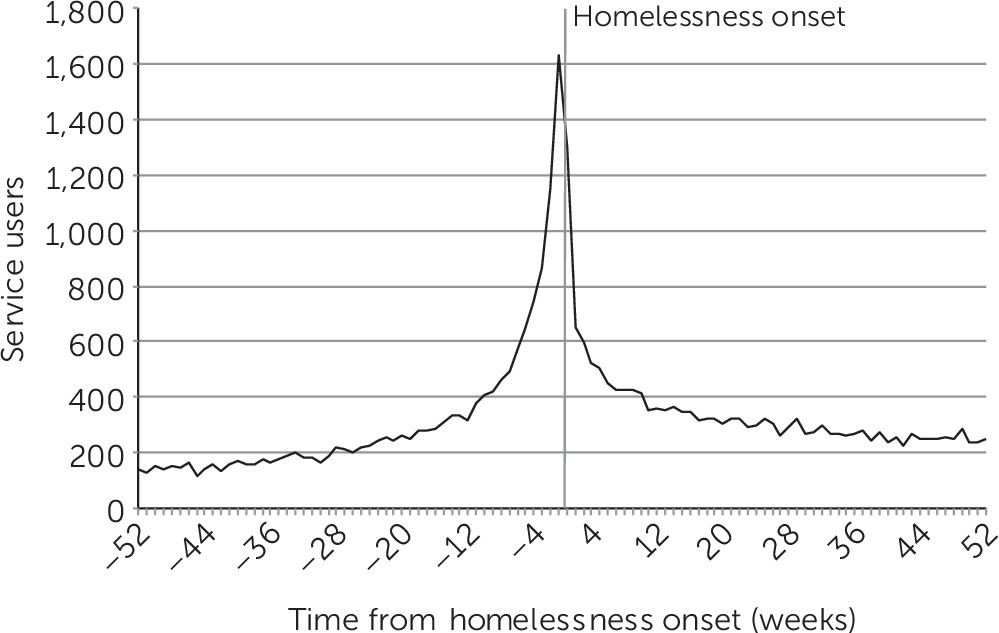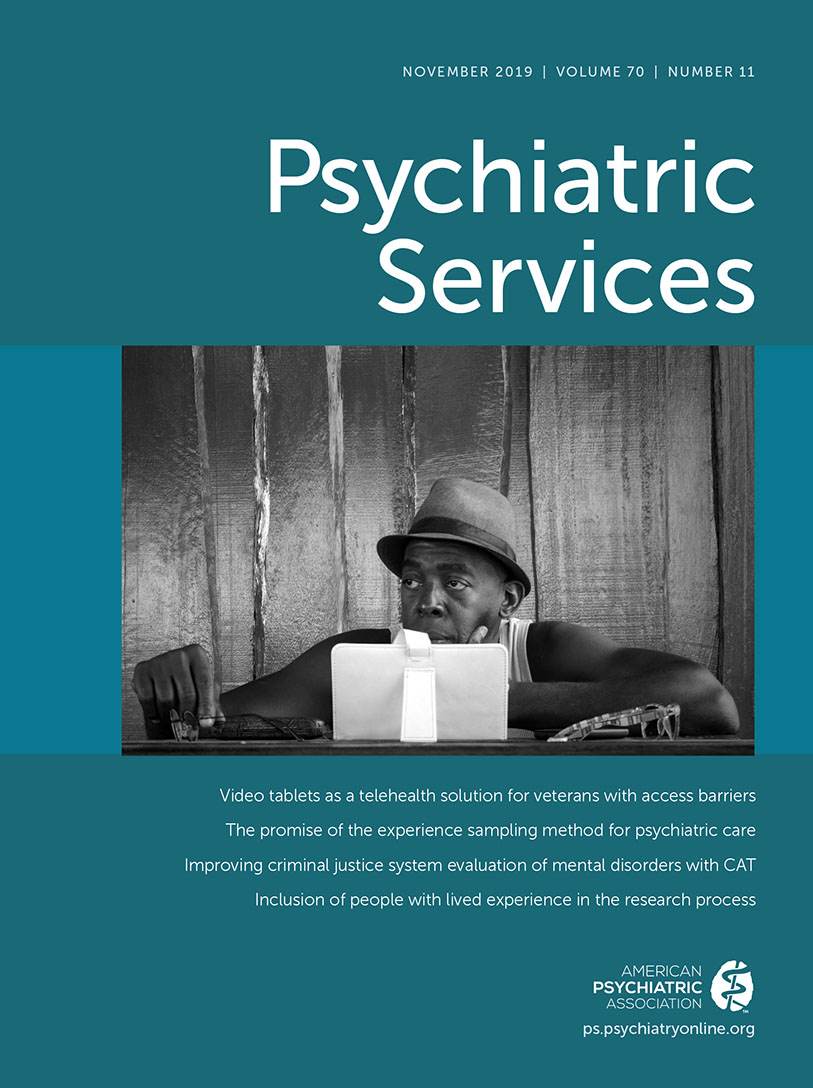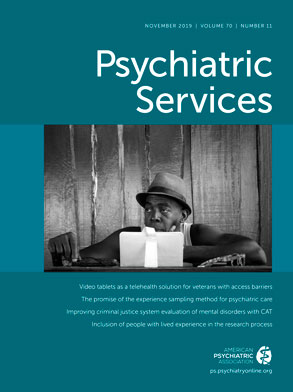Military veterans comprise a notable subgroup in U.S. suicide statistics (
1). In 2014, veterans accounted for 18% of all U.S. adult deaths by suicide, even though they constituted only 8.5% of the adult population. After adjustment for differences in age and gender, risk of suicide was 21% higher among veterans, compared with U.S. civilian adults; the rate of suicide among all veterans was 35.3 per 100,000, compared with 26.2 per 100,000 for civilian adults (
2). In 2014, an average of 20 veterans died from suicide each day, and only six of the 20 were users of U.S. Department of Veterans Affairs (VA) health care services (
1). The risk of suicide is especially high among older adult veterans, who in 2014 accounted for approximately 65% of all suicides among persons in the United States age 50 years or older (
1).
Veterans represent a significant minority of the U.S. homeless population. Although veterans make up only 7.9% of the U.S. population as a whole, they account for approximately 11% of the U.S. homeless population (
3). Recent studies of cause of death and mortality risk among homeless veterans have shown that compared with veterans with no history of homelessness, veterans with a history of homelessness had an increased rate of all-cause mortality and of suicide (
4,
5). Among younger veterans (ages 30–54) with no history of homelessness, suicide was found to occur as frequently as in the adult civilian population in the same age range. In contrast, the frequency of suicide among homeless veterans was 2.5 times that among the veterans with no history of homelessness; homelessness was associated with a hazard ratio for death by suicide of 2.7. Among older veterans (ages 55 and older), suicide was also rare but occurred with a frequency twice that of veterans with no history of homelessness and of the age-equivalent adult civilian population. These data are consistent with findings reported by McCarthy et al. (
6), who found that the suicide rate among veterans with homelessness in the past year was 81.0 per 100,000, compared with a rate of 35.8 per 100,000 among veterans without a recent history of homelessness.
Consistent with the reported high rates of completed suicides among homeless veterans are studies examining suicidal ideation and suicide attempts. In a systematic review of published studies, Hoffberg et al. (
7) reported rates of suicidal ideation of 1.3%−7.0% for the past week and 12.1%−18.0% for the past 30 days—and lifetime rates as high as 74%. For suicide attempts, reported rates in samples of homeless veterans ranged from 0% to 6% for the past 30 days and 30.7%−31.5% for the past 5 years. A recent analysis of survey data by Tsai et al. (
8) examining suicide attempts in the previous 2 years found that veterans with any homelessness experience had five times the rate of attempts as veterans without homelessness experience (6.9% versus 1.2%), and rates of suicidal ideation in the past 2 weeks were 2.5 times higher (19.5% versus 7.4%).
In summary, epidemiological research has provided substantive evidence to support the growing concern about suicides among veterans and especially homeless veterans. Although studies have identified an array of risk factors for suicide, effect sizes are small to moderate and offer little guidance to clinicians who are faced with identifying veterans at risk of suicide. It is now clear that homelessness or a history of homelessness is associated with an increased risk of death by suicide; however, rarely is suicide per se a focus of clinical inquiry in the assessment of homelessness risk, or vice versa. Most important, epidemiologic studies documenting increased lifetime risk of suicide among homeless veterans do not inform clinicians of the critical time frames within which this risk occurs, an important issue in determining the need for focused and timely intervention. This study examined the temporal sequencing of episodes of homelessness and treatment for suicidality and their general co-occurrence.
Methods
This study was approved by the Tampa VA Research Committee and the Institutional Review Board at the University of South Florida. A waiver of the consent process was approved for this use of archived data. Study data were provided by the VA Corporate Data Warehouse and consisted of medical records containing service use dates and associated ICD codes for health care provided by the Veterans Health Administration. For all analyses, suicidality was indicated by primary or secondary diagnoses of suicidal ideation (V62.84 in ICD-9 and R45.851 in ICD-10) or suicide attempt/self-inflicted injury (E950–E959 in ICD-9 and T14.91 and X71–X83 in ICD-10) in inpatient or outpatient settings. Homelessness was defined as a primary diagnosis of V60.0 (ICD-9) or Z59.0 (ICD-10).
In the first set of analyses, ICD codes were selected for veterans’ health care utilization from 1 year before to 1 year after the “onset” of homelessness, operationally defined as the date on which homelessness was first recorded in the patient record. The sample consisted of 152,519 veterans with a first indication of homelessness in the period from January 1, 2014, through June 30, 2016, and with no prior history of homelessness so denoted back to January 1, 2011. Demographic characteristics (race-ethnicity, sex, age, and marital status) were compared for those treated for suicidality within 30 days of homelessness onset and those treated for suicidality within 31 or more days of homelessness onset.
For the second analysis, which examined the rate of treatment for suicidality among all veterans experiencing homelessness, a sample of all veterans with any indication of homelessness in the period from January 1, 2013, through June 30, 2016, was selected (not just veterans with a first indication or onset of homelessness during the period). A total of 312,575 veterans met the inclusion criterion; however, a 50% random sample (N=156,288) was used to reduce data processing time. ICD codes were again selected for veterans’ health care utilization from 1 year before to 1 year after evidence of homelessness.
For the third analysis, which examined the rate of homelessness among veterans treated for suicidality, a sample was selected of veterans receiving treatment for suicidality in the period from January 1, 2013, through June 30, 2016. For veterans with evidence in the record of suicidality on multiple dates, one date was chosen at random as the index event. The sample size was 145,770. ICD codes associated with veterans’ homelessness from 1 year before to 1 year after the index event were selected.
Results
Figure 1 presents weekly counts of suicidality-related treatment encounters in the year before and after the first record of homelessness (veterans could have multiple suicidality treatments). This figure shows a clear temporal relationship between homelessness and suicidality. Notably, treatment for suicidality peaked just before the onset of homelessness, not after. A sharp acceleration in treatment for suicidal ideation and behavior was noted in the 8 weeks prior to onset of homeless, with a mirror deceleration in the 8 weeks after onset. The analysis comparing veterans treated for suicidality within 30 days of homelessness onset and those treated for suicidality outside that window showed statistically significant differences (p<0.05) in sex and age, but the effect sizes were quite small [a table in an
online supplement to this report presents these and other findings].
To assess the prevalence of suicidality occurring around the time of homelessness onset, we calculated the cumulative percentages of veterans with suicidality-related treatment encounters at 15, 30, 45, and 60 days before and after homelessness onset. These percentages were deduplicated. Results showed that 5.8% of veterans with an initial indication of homelessness received treatment for suicidality within 60 days either before or after homelessness onset [see figure in online supplement].
To quantify the extent of the increase in suicidality around the onset of homelessness compared with another period in the same veterans’ treatment records, we calculated the ratios of suicidality-related service use around the onset of homelessness to treatment rates 1 year prior. Results indicated that veterans were much more likely to receive suicidality-related care around the time they became homeless. This difference was most pronounced in the 2 weeks immediately surrounding homelessness onset, when veterans were more than eight times more likely to seek suicidality-related services [see figure in online supplement].
To assess the prevalence of suicidality among all veterans experiencing homelessness (not just at homelessness onset), the cumulative percentages of veterans with suicidality-related treatment encounters before and after any given homelessness documentation were calculated. Results indicated that 9.5% of homeless veterans showed evidence of suicidality in the year preceding a randomly selected treatment encounter with an ICD code for homelessness, and 6.9% did so in the following year [see figure in online supplement]. The unduplicated rate was 13% of suicidality treatment within 1 year of (before or after) any given homelessness documentation in the record.
To assess the prevalence of any homelessness among veterans with evidence of suicidality, the cumulative percentages of veterans with ICD codes for homelessness before and after a suicidality-related index event were calculated. Results show that 17.7% of veterans had evidence of homelessness in the year preceding suicidality-related care, and 23.6% had evidence of homelessness in the year after [see figure in online supplement]. An unduplicated 29.3% of veterans with a suicidality-related encounter had an indication of homelessness in their record within 1 year (before or after).
Discussion AND CONCLUSIONS
The results indicated that treatment for suicidality spiked around the onset of homelessness—and in particular in the days and weeks just prior to the first indication of homelessness in the medical record. Nearly 6% of veterans who experienced an initial indication of homelessness were treated for suicidality within 60 days (before or after) of homelessness onset. These findings suggest that either the circumstances most often associated with homelessness onset (i.e., family conflict, economic disruptions, and acute behavioral health conditions) are similarly triggering suicidality or that the sudden loss of housing itself has an independent effect on risk of suicidality.
A first-time experience of homelessness may be a particularly disturbing experience, accompanied as it may be by interpersonally and economically devastating events. Suicidality may increase with the sense of hopelessness, shame, and fear from the homelessness experience, which is characterized by unexpected hardships, such as sleeping rough or in public shelters, and the attendant risks of victimization and dehumanization. That the rate of suicidality within a 1-year period of any indication of homelessness rose to 9.5% suggests that the experience of homelessness by itself conveys additional risk of suicidality, beyond the circumstances which may have given rise to the onset of homelessness.
Another contributing factor for the co-occurrence of suicidality and an initial indication of homelessness in the medical record (here called “onset”) is that treatment for suicidality may reveal homelessness risk to providers and may lead to a referral to VA homelessness programs. We also speculate that some veterans may seek emergency and inpatient services as an adaptation to sudden housing loss. Some individuals may seek such services, directly or indirectly, as a means of shelter, and a suicidality diagnosis may be given to provide a justification for a crisis bed placement. This deserves further investigation.
Among veterans treated for suicidality, homelessness was a very common co-occurring condition. Indeed, 29% of those treated for suicidality experienced a homelessness event within 1 year of their treatment. Such a high rate of co-occurring homelessness and suicidality suggests that homelessness and its related social isolation and interpersonal disruptions are potentially important contributors to the disproportionate suicidality among veterans overall and that homelessness must be considered as a primary risk factor for suicidality. Recent research on homeless service users of acute care outside the VA, particularly the use of hospital emergency departments around the onset of homeless service use (unpublished manuscript, Treglia D, Johns EL, Schretzman M, et al., 2019), suggests that the temporal associations in VA data may be found in other systems.
The findings show that sensitivity to suicidality risk is indicated at VA clinics that screen for homelessness risk and among providers working with veterans who are at risk of homelessness or already homeless. When possible, providers can screen for suicide risk and make appropriate referrals. A positive screen for homelessness risk may also suggest a need to educate veterans about the successful interventions available to address homelessness and to provide reassurances that homelessness is mostly a short-term condition that is resolvable with the assistance of VA programs. Patients treated for suicidality at VA emergency departments and inpatient settings, where the homelessness risk screener is not deployed, should be screened for homelessness risk and appropriate referrals made to VA homelessness programs. These activities all fall under the recently released
National Strategy for Preventing Veteran Suicide 2018–2028 (
9), which aims to enhance risk screening, identification of suicide vulnerability, and access to services, with the goal of reducing veteran suicidal behavior.
This study’s reliance on VA medical record data led to several limitations. First, in the absence of death record data, our definition of suicidality excluded those who died by suicide. Second, data were limited to suicidal ideation and suicide attempts for which veterans received treatment at the VA. The same was true for homelessness, because we could study homelessness only among veterans who sought VA services. Finally, the study was limited to veterans eligible to receive VA care.


